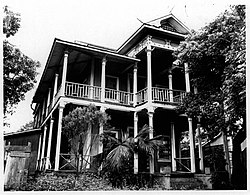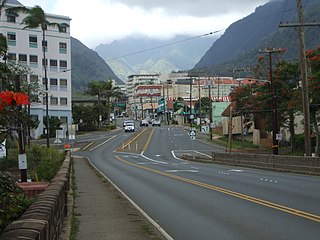
Wailuku is a census-designated place (CDP) in and county seat of Maui Island, Maui County, Hawaii, United States. The population was 17,697 at the 2020 census.
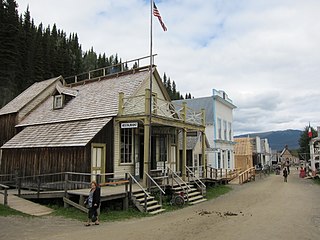
Barkerville was the main town of the Cariboo Gold Rush in British Columbia, Canada, and is preserved as a historic town. It is located on the north slope of the Cariboo Plateau near the Cariboo Mountains 80 kilometres (50 mi) east of Quesnel. BC Highway 26, which follows the route of the Cariboo Wagon Road, the original access to Barkerville, goes through it.

Ping Shan Heritage Trail is a heritage trail located in the Ping Shan area of Yuen Long District, in Hong Kong. The trail was inaugurated on 12 December 1993 and was the first of its kind in Hong Kong. It passes through the villages of Hang Tau Tsuen, Hang Mei Tsuen and Sheung Cheung Wai and it includes several declared monuments and graded buildings.

This is a list of properties and historic districts in Hawaii listed on the National Register of Historic Places. More than 340 listings appear on all but one of Hawaii's main islands and the Northwestern Islands, and in all of its five counties. Included are houses, schools, archeological sites, ships, shipwrecks and various other types of listings. These properties and districts are listed by island, beginning at the northwestern end of the chain.
This National Park Service list is complete through NPS recent listings posted February 16, 2024.

The Wilcox, Crittenden Mill, also known as Wilcox, Crittenden Mill Historic District, is a 17-acre (6.9 ha) property in Middletown, Connecticut that was listed on the National Register of Historic Places in 1986. It was the location of the Wilcox, Crittenden company, a marine hardware firm. The historic district listing included four contributing buildings and three other contributing sites.

The ʻĪao Theater is a Spanish Mission style theater opened in 1928, in the city of Wailuku, Maui, Hawaii. It was originally both a movie and vaudeville house, until it fell into disrepair in the 1980s. Facing possible demolition, in 1994, it was listed on the State of Hawaii's Register of Historic Places. It was placed on the National Register of Historic Places in 1995. It later became the home of Maui OnStage, a community-based theatrical organization.

The Wo Hing Society Hall was a building located at 858 Front Street in the Lahaina Historic District in Lahaina, Hawaii. Built around 1912, it served the growing Chinese population centered in Lahaina, primarily those working in the sugarcane industry as a social and fraternal hall for the Wo Hing Society. By the 1940s the declining Chinese population in Lahaina slowly made the building redundant and the property was neglected.
At their peak, there were six Chinese Society Halls on Maui. Operated by the Gee Kung Tong Society, these halls were created to provide services to immigrant Chinese workers, mostly working for the sugarcane plantations. All provided religious and political help, in addition to mutual aid. Only the Wo Hing Society Hall in Lahaina and the Ket Hing Society Hall in Kula have survived. Both were placed on the Hawaii State Register of Historic Places on July 30, 1982, and placed on the National Register of Historic Places on November 15, 1982. The Chee Kung Tong Society Hall was placed onto both State and Federal registers, but collapsed in 1996.

Hale Hōʻikeʻike at the Bailey House is a museum of Hawaiian history and art located in Wailuku, on the island of Maui, in Hawaiʻi. It is owned and operated by the Maui Historical Society. Old Bailey House is a historic district contributing property within the Wailuku Civic Center Historic District, and is on the National Register of Historic Places.

The Wailuku Civic Center Historic District is a group of four historic buildings and one non-contributing property in Wailuku, Maui Hawaii that currently house the governmental offices of both the County of Maui and the State of Hawaii. The historic buildings were built during a time span from 1901 to 1931. They incorporate several architectural styles and two of the four historic buildings were designed and built by Hawaii-based architect C.W. Dickey. The non-contributing property houses most of the County of Maui's main offices.

Wailuku Elementary School is a public elementary school operated by the Hawaii Department of Education, occupying a historic school building in Wailuku, Hawaii.
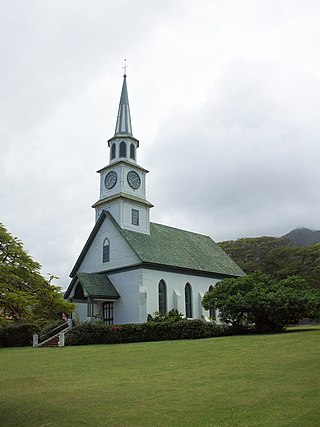
Kaʻahumanu Church is a church in Wailuku, Maui, Hawaii. The hymns and invocation in the services are in the Hawaiian language. which echo the legacy of Hawaiian churches in the survival of the Hawaiian language where it was banned from being spoken in public.

The Westerman Lumber Office and House is a historic building in Montgomery, Minnesota, United States. The private, commercial structure was placed on the National Register of Historic Places (NRHP) on March 15, 1982. The structure is considered an outstanding example of the brick buildings built in the area of Montgomery and New Prague during the late 19th century, using bricks manufactured in the Minnesota River Valley.
The Tong Wars were a series of violent disputes beginning in the late 19th century among rival Chinese Tong factions centered in the Chinatowns of various American cities, in particular San Francisco. Tong wars could be triggered by a variety of inter-gang grievances, from the public besmirching of another Tong's honor, to failure to make full payment for a "slave girl", to the murder of a rival Tong member. Each Tong had salaried soldiers, known as boo how doy, who fought in Chinatown alleys and streets over the control of opium, prostitution, gambling, and territory.
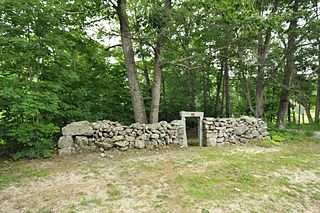
Turner Cattle Pound is a historic animal pound at the corner of Gen. Turner Hill Road and Kennebec Trail in Turner, Maine. Built in 1816, it is a well-preserved example of a once-common feature of New England's agricultural communities. It was listed on the National Register of Historic Places in 2009.

The Fred Baldwin Memorial Home was built in 1910 and endowed by Emily and Henry Perrine Baldwin to provide housing for elderly Hawaiian and haole men. It is named for their son Fred Baldwin (1881-1905). Its architect was H. L. Kerr, who had earlier designed the Old Wailuku Courthouse. In 2011, it was restored by Xorin Balbes to operate as an educational retreat named Lumeria Maui. It was added to the National Register of Historic Places on 1 December 2011.
The Commissioner's Office is a rare surviving example of transitional Spanish-Japanese architecture on the island of Rota in the Northern Mariana Islands, an insular area of the United States in the western Pacific Ocean. It is a single-story structure with walls of manposteria, a construction method adopted during the Spanish period. The window trim consists of ifil lintels, and the building's cornice is Japanese in style. At the time of the building's listing on the National Register of Historic Places in 1981, it was in deteriorated condition, lacking a roof and with one collapsed wall. The structure was built in the 1930s by the local Chamorro people, who had been displaced to that part of the island by Japanese settlement undertaken as part of the South Seas Mandate. The building housed the offices of a local commissioner, or village head responsible to the Japanese authorities. Many buildings built by the Japanese during the mandate period were destroyed in World War II.

The Pownal Cattle Pound is a historic stone animal pound in Bradbury Mountain State Park, Pownal, Maine. Built in 1818, it is one of a modest number of these once-common structures left in the state. It was listed on the National Register of Historic Places in 2004.
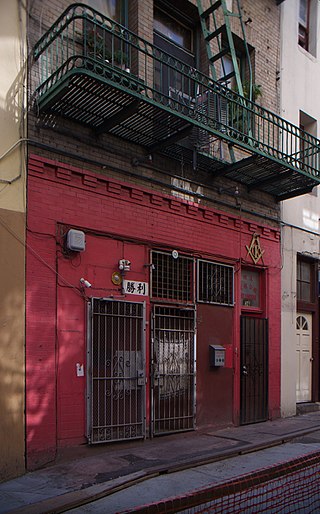
The Chee Kung Tong, or Gee Kung Tong, was a Chinese secret society established in 1880 and holds an active presence still. In earlier years, the society has also been recognized as the "Chinese Masons" and has been identified under various names such as Hongmen, Hongshuntang, and Yixingtang. The fraternity founded its headquarters in San Francisco in the United States.

The Chee Kung Tong Building is a Canadian historic building in Barkerville, British Columbia. The building is a rare surviving example of Canadian Chinese benevolent society architecture. It consists of a two-story wooden structure with two log lean-tos on the north and east sides and a balcony. The ground floor is divided into a hostel, kitchen, and socializing space and the top floor was divided between a society hall and an alter room. It is among the oldest surviving structures in the town.
